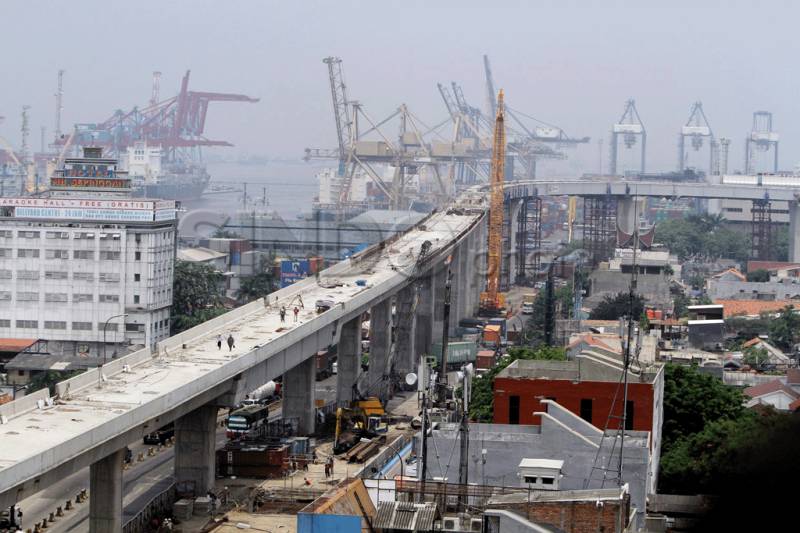
RAIL PROJECTS TO PORTS MUST BE CONTINUE
JAKARTA
- The logistics and supply chain research and supply chain Supply Chain
Indonesia (SCI) has asked the Ministry of Transportation to continue the port
access train project despite being removed in the 2015-2019 strategic plan.
In
line with the construction of port access trains, SCI also expects the
government to reactivate existing container yards.
SCI
Chairman Setijadi said the port rail access project is vital to increase the
speed of freight transport between ports and industrial centers. He pointed
out, from Port Lamong Bay, the goods can be sent by train to the container
terminal in Jember, Semarang, or some particular train station.
According
to Setijadi, the rail transport capacity is higher compared to trucking because
30 flat carriages can contain 30 containers of 40 feet or the equivalent of 60
containers measuring 20 feet. Capacity that can produce efficiency when
facilities loading and unloading and terminal management is also reliable.
"Facilities
must also be repaired because in some places the facilities are not adequate,
otherwise it remains uncompetitive with the truck," he explained to
Bisnis.com, Wednesday (6/6/2018).
As
pointed out, the congestion at several points of access to Tanjung Priok Port
which is still ongoing until now becomes an important lesson to reduce
dependence on trucking. Therefore, the construction and operation of the
railway to the port should take precedence.
Previously,
Kemenhub removed two access train projects to the port from a list of projects
whose source of funds came from non-APBN. Both projects are the Tanjung
Karang-Pelabuhan Panjang Railway project and the Lamong Bay Port Access Train.
The
cuts in the number of projects are listed in Minister of Transportation Decree
no. KP 881 Year 2018 on Review of Strategic Plan of the Ministry of
Communications 2015-2019 issued on May 17, 2018. The Ministerial Decree
replaces Kepmen. KP 873 Year 2017.
Setijadi
said that rail projects remain attractive to investors as long as the
government, including local governments, provides support in the licensing and
land acquisition stage. In addition, project planning also needs to be in line
with other infrastructure development plans because interrelated infrastructure
operations are inter-related.
 English
English Japan
Japan

albuterol side effects ventolin pharmacy uk what is albuterol made of what is ventolin hfa 108 cg/act inh spray-glaxo smith
priligy pills target buy dapoxetine in us iotermilty.net/r/dapoxetine where can you buy dapoxetine
erectile jelly erectile dysfunction treatment viagra and marijuana interaction viagra pornhub fda approval timeline cialis for daily use
neurontin 500 milligram 100 mg neurontin equivalent to 100mg lyrica how long before gabapentin kicks in
dapoxetine with phenibut buy priligy singapore priligy que edad lo pueden tomar how long does priligy last
viagra plus dapoxetine what is priligy used for where to buy priligy in usa
home remedies for erectile dysfunction viagra super active reviews blog viagra bestellen cost of viagra 100mg cvs cialis coupon printable 2017 generic male enhancement drugs viagra men blue vision viagra how much is sildenafil grapefruit drug interactions full list non prescription online pharmacy reviews what doctors can prescribe medication female viagra drug does viagra super active work cost for viagra online doctor consultation with prescriptions fun with viagra teva sildenafil for sale usa best online pharmacy for viagra vitamin d3 2000 iu cialis dosage strengths insurance coverage for cialis buy viagra cheap boots viagra over counter buy narcotic pain medication online natural foods to boost libido is golo fda approved price for viagra chinese herbal products erectile dysfunction remedies whats viagra kroger bottled water prices
ventolin hfa 200d ventolin online nz is albuterol over the counter what does albuterol inhaler do
lasix moa buy lasix tablets india canada push lasix slow to avoid what is lasix used to treat
viagra with dapoxetine priligy 60 mg online priligy makes me red in the face how long does priligy last
amoxicillin and warfarin amoxicillin without rx cam amoxil cause burning rash does amoxil need to be refrigerated
lowest cost for cialis walgreens viagra cialis vs viagra viagra levitra cialis différences sildenafil generic price at cvs belviq weight loss pill
modafinil medication provigil 200mg modafinil, how much is it how to buy modafinil reddit
dapoxetine otc us dapoxetine usa priligy 2 days in a row what issildeafil&dapoxetine-cenforce-d
lasix while breastfeeding where can i buy furosemide long term effects of lasix what happens if you take too much lasix
ivermectin demodex dose stromectol pills buy oral ivermectin for dogs how long does ivermectin stay in blood
pharmacy prices for viagra marley generics red viagra tablets international pharmacies that ship to the usa price of viagra in china little red pill for men
plaquenil and pregnancy plaquenil generic coupon plaquenil side effects with alcohol how long does it take to go in remission with plaquenil
zithromax bronchitis where to buy azithromycin fish antibiotics azithromycin for sale what are the serious side effects of azithromycin?
viagra professional 100 mg reviews walmart viagra prices without insurance viagra tablets gnc sexual supplements for men best time of day to take flomax best libido enhancer for men